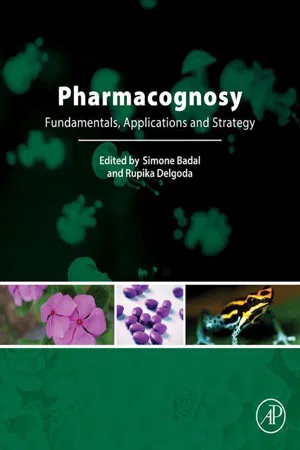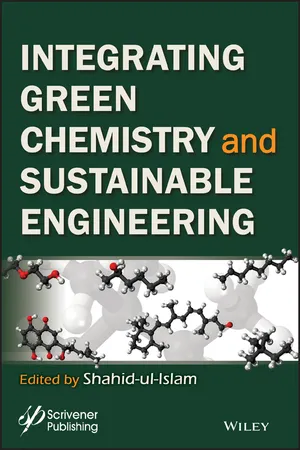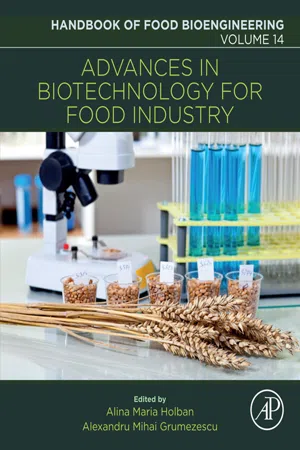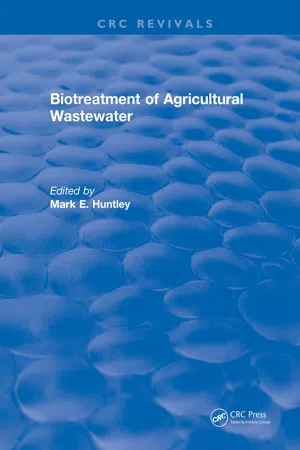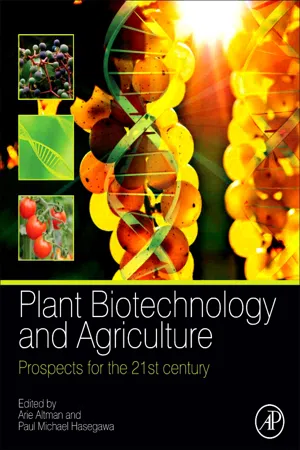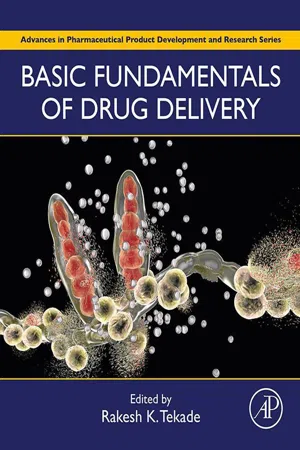Biological Sciences
Role of Biotechnology
Biotechnology plays a crucial role in harnessing biological systems and processes for various applications. It involves the use of living organisms or their products to develop new technologies and products in fields such as agriculture, medicine, and environmental management. By manipulating biological systems at the molecular and cellular levels, biotechnology has the potential to address global challenges and improve human well-being.
Written by Perlego with AI-assistance
Related key terms
7 Key excerpts on "Role of Biotechnology"
- eBook - ePub
Pharmacognosy
Fundamentals, Applications and Strategies
- Rupika Delgoda, Simone Badal McCreath(Authors)
- 2016(Publication Date)
- Academic Press(Publisher)
[4] in the United States describes modern biotechnology as incorporating “a specific focus on industrial usage of recombinant deoxyribonucleic acid (rDNA), cell fusion, and novel bioprocessing techniques; industrial use of living organisms.”Biotechnology is therefore a multidisciplinary and interdisciplinary field, rather than a single discipline, that has given rise to a range of products and processes in life sciences. The technology has been applied to the development of new medicines, improved crop plants and animals, as well as the more efficient manufacture of everyday products. A color code was created to distinguish between the various applications. Red, green, white, and blue biotechnology refer to applications to medicine, agriculture, industry, and marine and aquatic environments, respectively; these are further explained in later sections of the chapter.28.2 Biotechnology, Bioengineering, and Biomedical Engineering
Depending on the tools and applications, there is notable overlap with biomedical engineering or bioengineering and biotechnology [5 ,6] . Biomedical engineering or bioengineering is a rapidly growing transdisciplinary field that is regarded as the bridge between technology, medicine, and biology. In other words, the primary focus of bioengineering is the application of the principles of engineering and design concepts to medicine and biology. Harmon in 1975 defined bioengineering as the “field that uses the tools and concepts of the physical sciences to analyze biological systems” [7] . In 1997, the US National Institutes of Health (NIH) published its working definition: “Bioengineering integrates physical, chemical, or mathematical sciences and engineering principles for the study of biology, medicine, behavior, or health; it advances fundamental concepts, creates knowledge form the molecular to the organ systems levels, and develops innovative biologics, materials, processes, implants, devices, and informatics approaches for the prevention, diagnosis, and treatment of disease, for patient rehabilitation, and for improving health” [8] . Although NIH’s definition of bioengineering is focused on human health, which is a key component of biological engineering, bioengineering also addresses the full spectrum of life sciences, including applications to agricultural, environmental, and ecological systems [9] - Shahid Ul Islam, Shahid Ul-Islam(Authors)
- 2019(Publication Date)
- Wiley-Scrivener(Publisher)
The first question arises what biotechnology is? This interesting science has developed from where? What is the development and progress of this science? What are the applications of biotechnology? Biotechnology is how much important for the society? What are the advantages and disadvantages of biotechnology in all senses? The ethical issues and analysis of all the points are compiled within this chapter. Without forgiving the answers to all these questions we presented the detail in the chapter. The faiths and facts are covered in this chapter.Biotechnology is a vast area of research where the new technologies are developed by using cells and cellular materials, organisms, biological processes. It has a large impact in the research field for developing the new product for sustaining life. The word invention is better suited to the word biotechnology. It is the science which can be applied directly in every field.Biotechnology is the branch which is developed for the welfare of human beings and living things by using the available organisms with the processes like genetic engineering, immunology, microbiology and biochemistry.Biotechnology is a term which can be seen in college, newspaper, media, books, journals, agriculture, sports, meetings etc. It is the science which involves the use of living organisms and biological systems to improve and develop the applications of technologies. This is the modern, newest, important and maybe the controversial field because of its use and applications. Simply if we consider a technique or technology, then biotechnology is the solution to all the problems. The correlation of nature and human being is the basic concept of life on Earth. It is helpful in each moment of life from morning to sleeping time for better health, to improve the quality of not only human beings but also living creature included in the environment.By considering the route of biotechnology from past to present and up to future this field shows the use of living cells from micro-organisms to humans. Biotechnology is an important branch mainly involving the basis of life that is cell. Thereby the work in the biotechnology field includes yeast, plants, animals, bacteria, algae and humans as well. In this sense, cells obey the thermodynamics laws to verify biochemical and physical features.- eBook - ePub
- Gopal Kumar Sharma, Anil Dutt Semwal, Dev Kumar Yadav(Authors)
- 2021(Publication Date)
- CRC Press(Publisher)
10 Progression of Biotechnology and its Application in Food ProcessingJanifer Raj Xavier1 * and Gopal Kumar Sharma21 Fruits and Vegetables Technology Division, Defence Food Research Laboratory Defence Research and Development Organisation, Siddharthanagar Mysuru-570 011, Karnataka, India2 Head, Grain Science Technology Division, Defence Food Research Laboratory Defence Research and Development Organisation, Siddharthanagar Mysuru-570 011, IndiaIntroduction
Biotechnology is defined as the ‘application of scientific and engineering principles to the processing of material by biological agents to provide goods and services’. The term ‘biotechnology’ is also used when a technique involving live organisms are employed to make or modify a product, improve plants or animals or develop microorganisms for specific uses. According to the definition of the Codex Alimentarius Commission (CAC 2001), modern biotechnology is defined as the application of (i) in vitro nucleic acid techniques, including recombinant deoxyribonucleic acid (DNA) and direct injection of nucleic acid into cells or organelles, or (ii) fusion of cells beyond the taxonomic family, that overcome natural physiological reproductive or recombination barriers, and that are not techniques used in traditional breeding and selection. Scientific developments of present world owe to processes and products of the field of biotechnology. Modern biotechnological advancements have played a major role in important branches of science such as agriculture, food processing, medicine and veterinary applications. Biotechnological interventions of the downstream processing applications include primary production areas namely breeding of crops and livestock, production of additives for food and feed and pharmaceuticals along with diagnostic tools. Inputs for food processing applications from biotechnology include biocatalysts such as enzymes, tracing food ingredients such as Genetically modified (GM) ingredients in end products of food and feed and food quality testing applications for food borne pathogens. Applications of modern biotechnology in form of genetically modified organisms have gained much importance in comparison to the downstream applications during food processing and food safety (Zhu, 2017 - eBook - ePub
- Alexandru Mihai Grumezescu, Alina Maria Holban(Authors)
- 2018(Publication Date)
- Academic Press(Publisher)
Chapter 1Role of Biotechnology in the Agrofood Industry
Mario Trejo-Perea José G. Rios-Moreno Gilberto Herrera-Ruiz Ana A. Feregrino-Pérez Irineo Torres-PachecoRamon G. Guevara-Gonzalez Autonomous University of Queretaro, Santiago de Querétaro, MexicoAbstract
Biotechnology is the application of various scientific techniques to modify, improve, and increase the value of various foods, animal, plants, and microorganisms of economic interest. This discipline has been developed since ancient times, that is, the Aztecs or tribes of Chad used microorganisms, such as cyanobacteria for nutritional intake. During the first and second world war, yeasts were added to satisfy the nutritional needs of the population because of food shortages. In addition to this for several decades the molecular and genetic techniques, named today as “omics,” have brought great changes in foods, such as genetically modified foods. Likewise, the industry has been benefited because of the transformation of various food by using processing technology, the latter being one of the centers of high-tech 21st century. Within this processing technology, it is found that the automation systems have increased the quality of products, the production and the shelf life, reducing costs and material waste by human error, which impacts a better use of natural resources. However, the progress in the use of this science leads us to make decision schemes or real problems, such as what is the role of intellectual property to reward innovation and allow access to the technology developed or which are environmental risks to genetic modification? Thus, it is of great interest to evaluate the benefits and risks of biotechnology application in the agrofood industry. - eBook - ePub
- Mark E. Huntley(Author)
- 2018(Publication Date)
- CRC Press(Publisher)
The flexibility and evolution of the NIH guidelines, in response to an expanding knowledge base of the limitations and safety of recombinant DNA technology, have been largely responsible for the structured growth and transition from basic and applied research to the development and use of living organisms and their parts and processes to benefit mankind. Opportunities abound for the use of “tailor-made” microorganisms and their protein products in product-oriented areas such as health care, agriculture, commodity and specialty chemicals, and environmental protection. 2 The direct use of microorganisms and their capabilities to solve environmental problems and for in situ agricultural and industrial applications can be defined operationally as environmental biotechnology. Applications include detoxification and/or destruction of pollutants and hazardous wastes, improvements in soil fertility and crop productivity, biological pest management, and restoration and renovation of perturbed ecosystems. Environmental biotechnology is differentiated from other areas of biotechnology in that successful process development must contend with the complexity of mixed (heterogeneous) populations and interactions occurring in ecosystems, as well as by the fact that the technology itself may be the subject of concern over environmental hazards - eBook - ePub
Plant Biotechnology and Agriculture
Prospects for the 21st Century
- Arie Altman, Paul Michael Hasegawa(Authors)
- 2011(Publication Date)
- Academic Press(Publisher)
Introduction to plant biotechnology 2011: Basic aspects and agricultural implicationsArie Altman1 and Paul Michael Hasegawa2
1 Hebrew University of Jerusalem, Israel,2 Purdue University, IndianaThe Role of Plants and Agriculture: Food Security, the Changing Environment and Novel Biomaterials
Current agricultural crops are products of plant domestication, along with gradual long-term changes in their qualitative and quantitative traits because of continuous natural and human-directed selection. Whereas some of the first improvements in plants and animals could have resulted from chance alone, the eye and brain of the “primitive” scientist-farmer were crucial in selecting the good from the bad, and the productive and quality crop from the less worthy. Thus, advancements in agriculture and plant science are, primarily, the result of scientific discoveries and judgments, historic innovations, and are sometimes revolutionary, such as fermentation of food products, use of inorganic fertilizers, and more recently, plant genetic transformation.Man-made technologies and biotechnologies, including food and fiber, have shaped human life since time immemorial. Fermented plant and animal products (e.g., bread, cheese, and wine), conventional crop breeding since the birth of agricultural communities, the “Green Revolution” of later years, and molecular marker-assisted selection and recombinant DNA techniques are all biotechnologies by definition (Meiri and Altman, 1998 , Altman, 1999 and Chrispeels and Sadava, 2003 ; Science, 2010). The urgent need to look for alternative biotechnologies and the actual accelerated rate of adopting plant molecular biotechnologies since the breakthrough report of the first transgenic plant in 1982–1983 (Otten et al., 1981 and Barton et al., 1983 ) is due to four major causes:1. Increase in world population and the need for more food 2. Recognition that human health is affected by disease-causing pathogenic organisms and by the nutritional quality of foods, especially vitamins and minerals - eBook - ePub
- (Author)
- 2018(Publication Date)
- Academic Press(Publisher)
Bionanotechnology is unique against all the major technologies of the 21st century. It has a dramatic effect on the social structure and economy of the world (Bhushan, 2017). Bionanotechnology is the intersection of biological research with various aspects of nanotechnology (Fig. 12.1). Figure 12.1 Combining biotechnology with nanotechnology. It is the implication of nanotechnology to expand the horizons of biology. Nanotechnology refers to research and manipulations of matter at nanoscale or 1–100 nm ranges. It refers to a vast range of research in various disciplines like industrial, agricultural, nanomedicine, food, dairy products, nanoelectronics and nanomaterials, etc., where the common trait is nanosize. Biotechnology also refers to applications of various recent research techniques to biological systems, living organisms, and their physiological and metabolic processes to produce and modify products, or it can be understood as the application of biological systems, organisms, microbes, and biological processes for crop research, food and pharmaceutical research, etc. (Jain and Jain, 2017 ; Zhang et al., 2017). The perception of scientists behind the bionanotechnology interdisciplinary research is that it has great potential to revolutionize our future; nanotechnology will cater to the needs of biological research, giving a depth of understanding and working with biological molecules such as bacteria, toxins, proteins, nucleic acids, etc. at nanoscale while biological principles can be applied with nanotechnology for understanding and manipulation of cellular processes and molecular interactions for development of cellular and genetic products (Fig. 12.2). Figure 12.2 Understanding tools and interaction between a biological system and nanomaterials. However, the use of nanotechnology in biotechnology has certain limitations, which are indicated in Fig
Index pages curate the most relevant extracts from our library of academic textbooks. They’ve been created using an in-house natural language model (NLM), each adding context and meaning to key research topics.
